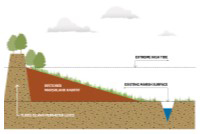
Tidal marsh restoration by Audubon (BirdLife in the USA) in the San Pablo Bay Important Bird and Biodiversity Area (IBA) is reducing storm-surge risk for neighbouring landowners, while providing important habitat for threatened waterbirds such as the Black Rail Laterallus jamaicensis.

Ecosystem-based approaches can form an important part of human adaptation and disaster risk reduction strategies. Maintaining and enhancing mangroves, tidal marshland and other ‘natural infrastructure’ can buffer people from changes in climate that we expect to see in the coming century; increasing extreme weather events, rising sea levels and changing rainfall patterns (IPCC 2014, Jevrejeva et al. 2012). At the same time, these efforts ensure that habitats continue to support bird and other wildlife populations and provide ecosystem services such as food, water filtration and crop pollination in a changing climate.
A project led by Audubon California is restoring 400 ha of tidal marshland in the San Pablo Bay National Wildlife Refuge along Sonoma Creek. The creek runs from Sonoma County into San Pablo Bay and the surrounding areas have seen extensive land use change through agriculture and mining in the past few decades. Much of the wetlands have now been reclaimed by the sea, limiting the lands value for agriculture, with much being either abandoned or sold.
The project will involve producing a tidal channel network across the wetland to improve tidal exchange and nutrient cycling, whilst also creating important habitat for marsh dependent species. Improved water quality will result from improved circulation and hydrology of the area, will reduce the need for pesticides and should reduce mosquito production in some of the pools. Construction of a sloped high marsh transition zone will also be of benefit with rising sea levels and increased coastal storms; reducing flooding of private land and providing high tide refuge for a range of species.
Benefits will therefore be seen for both people and wildlife, through land reclamation and reduced mosquito prevalence, and improved habitat for many of the birds found within the San Pablo IBA—Brown Pelicans Pelecanus occidentalis, White-tailed Kites Elanus leucurus and Common Yellowthroats Geothlypis trichas.
This case study is taken from ‘The Messengers: What birds tell us about threats from climate change and solutions for nature and people’. To download the report in full click here.
Related Species
References
Compiled: 2015 Copyright: 2015
Recommended Citation:
BirdLife International (2015)
Restoring tidal marshes in San Pablo Bay, USA, benefits birds and people.
Downloaded from https://datazone.birdlife.org/sowb/casestudy/restoring-tidal-marshes-in-san-pablo-bay-usa-benefits-birds-and-people on 22/12/2024